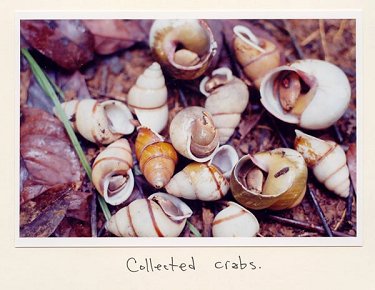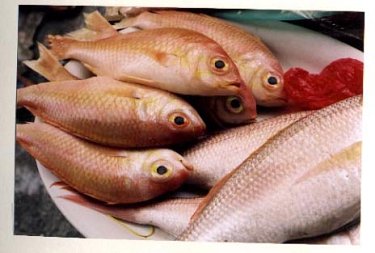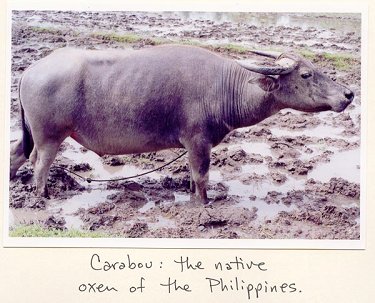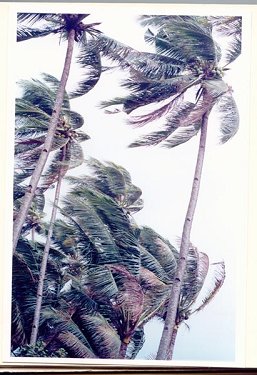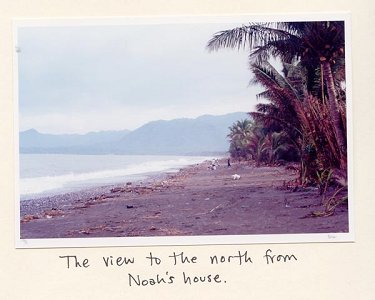|
|
Callan Bentley Philippines |
|
Pandan
Move to Pandan
After the better part of a week in Cubay, the day came when Noah’s boss Eric was leaving. Noah had volunteered to drive Eric to the airport, and would then return to move into the vacated house on the beach in Pandnan. We picked Eric and Jill and Fel up, and then drove to Caticlan, a village on the other side of the island. Fel was fawning in the Jeep, a bit of a sycophant towards Eric. Caticlan has an airport because it is the gateway to the tourist island of Borocay. This “jump off point” for Borocay had a very different flavor than the backwaters of Cubay and Pandan: there were advertising billboards and restaurants serving German beer, and in general, a greater feeling of affluence based on tourists spending money as they passed through. We were passed by hordes of rich Koreans, sunglasses and nailpolish and strappy sandals. Eric and Jill treated us to a glass of fresh mango juice, we say goodbye, they get on the plane, they fly away.
Because Noah and I were broke, we had been planning on taking a jaunt across the water to Borocay. We had need of the ATM and e-mail resources that were only available there. However, we were forced to ditch our plan to go to Borocay because Fel had to go to the bank, and he was being difficult. He and Noah had a tense discussion that bordered on a spat. They were different people with different agendas, and Noah was getting very frustrated. We stopped to get a snack, and Fel waited in the car. Noah vented his frustration to me in a strained whisper while we walked a short distance to the store. He was beet-red as he told me, “This happens…all…the fucking…time.” We got back in the car, a tense situation: me and Fel and Noah, the counterparts who were each fuming at the other for impinging on each other’s plans. I gave up, realizing that I could not talk to Noah while Fel was there, and that I could not make the requisite smalltalk with Fel without driving Noah crazy. I lay down in the back seat and go to sleep. They traded turns playing music: Noah playing a folk music tape that I brought from the States, Fel playing pop crap like the Backstreet Boys. It was a relief to get back to Pandan and part company. Noah’s house is made of bamboo and roofed in a native frond called nipa. The nipa is arranged in bushy layers, like shingles. The bamboo slats that comprise the floor are elevated a meter or so above the ground; they flex slightly as I walk through the three-room house. There is running water, which Noah says is safe to drink. I take full advantage of the shower in the bathroom. At Lolo and Lola’s house, I had bathed with a bucket and ladle, squatting on a concrete floor. As a consequence, I never really felt clean. Here at the nipa hut, I stood up on a white tile floor and turned a knob: the showerhead immediately began spraying. Sweet luxury: I felt very American. I had developed a rash due to the humid tropical heat, a series of raised red bumps across my chest and back. Noah, the eternally-wounded, gives me a cursory glance, and tells me not to worry, “That’s nothing.”
Housewarming
I like the nipa hut, it seems like a good place to live. I am relaxing after the stressful jeep ride, reading and feeling clean(er). But no sooner have I stretched out and gotten into my book than Noah returns with guests! Silent rest postponed, I sit up and meet them. There are four: three British citizens, one a traveler like me, the others a couple who work as VSO volunteers on another Philippine island, Sibuyan. The VSO is the British equivalent of the Peace Corps. The fourth person is a Filipina, native to Sibuyan, named Zita.
Zita was a former coworker of Noah’s when he lived on Sibuyan. She is now the counterpart of the VSO couple. The other British girl was just visiting her friends, when the trip to Panay was launched. She had no choice to tag along. Zita did have a choice about coming along, since she had no upfront motive for making the trip. However, the longer I watched how she related to Noah, it soon became obvious enough what her motives were. Zita is edgy and flamboyant and skinnier than it seems like she should be. She is loud and brash and articulate in the English language, including crude slang. Meeting her for the first time, my instant impression was that she loves fun in its myriad modern forms. She seemed a little unstable, but suddenly, the first evening in Noah’s new house, we had a party going: Who was I to be a stick in the mud? We all had a welcome-to-Pandan beer, and then I went off shopping. This was my first solo shopping trip, and I daresay it was successful. It’s amazing how far you can get on just a bit of sign language and a smile. I bought a bunch of vegetables and eggs and cooked up a spicy stir-fry for the assembled party. Noah’s pal Boy came by too, which made for seven in all. It was a fine way to “house-warm” a new nipa hut. We stayed up late sharing our three cultures and customs and our impressions of the one country that we all had in common: the Philippines. Around 10pm, the Brits left to go stay in a hotel, but Zita stayed where she was. I went to sleep not long after that, leaving Noah and Zita up and popping the tops of more San Miguel, and catching up on old times.
The Morning After
I slept on the porch, but a squall came through in the middle of the night, and I had to move my sleeping bag inside the little storage room.
I woke up and stretched. Sitting in my sleeping bag, I realized how light-tight the small room was. The sun had risen outside, but the only place that light came in was between the bamboo slats of the floor. I wondered at the efficiency of the walls at blocking out light so well, yet the holey design of the floor: why would they build it this way? (I would soon find out) I opened the door and went out on the deck. It had stopped raining. I gazed in a sleepy way out over the ocean to the south and west. Blinking away the sleep, I felt good. I walked down to the surf, and waded in. I swam out a short ways, floating and side-stroking to compensate for the longshore current. Usually the first thing I do upon waking in the mornings is to start some coffee brewing. It is rare for me to feel the motivation to get up and immediately go. But it was delightful, to be hanging in the Sulu Sea, looking back on the forest-draped mountains of Panay, rising up like any tropical island you have ever seen; Gilligan or a skinny Tom Hanks would find their roles here easily. Golden sunlight arced over the crest of the mountains, causing a glossy sheen on the palm fronds and nipa leaves. A few bats skirted the canopy, late in returning to roost after their nighttime feeding. Out in the ocean, boats were floating: fisherman trying for an early catch. The Filipino boat is a simple affair like a canoe, but with two large bamboo outriggers. Unlike the thinner supporting framework, the outriggers are made of substantial bamboo, at least six to seven inches in diameter. It has an appearance like a spider dividing its legs between two skis and a surfboard. As I floated there, waking up and facing inland towards the rising sun, a persistent breeze approached from behind my head, out to Sea. After a while, Noah emerged from the house and made his way down to the waves. As he swam up beside me, he had a strange look on his face. I suspected something was up. Not wanting to let on that I had noticed, I waited for him to bring it up. He eventually did; telling me that Zita had made a pass at him late the previous night. HE told me that he had responded at first, full of the glee of being the master of a new house (not to mention full of San Miguel). Then, Zita apparently started seriously trying to seduce Noah, which he resisted. This left her offended, he told me, and they went to sleep on less-than-good terms. I raised my eyebrows and swam a few strokes along the shore. We talked it over, as men will do. Noah was worried that he had permanently soured his relationship with his friend. I was just glad that she was only visiting, and would soon be gone. The last thing I felt like dealing with was a jaded stranger from another culture living in the same two-room house as me. That was the day that the typhoon started.
The Typhoon Begins
The “persistent breeze” that had been blowing from the southwest intensified through the course of the day. It was a sort of wind that we do not ever experience in North America. This typhoon wind was steady and constant, not gusty. It just continued to blow and blow and blow, hitting the beach at Pandan head-on; the shoreline perpendicular to the main force of the wind.
The rain came in mid-afternoon, joining the wind by degrees, until at sunset, the two were one: an unvarying horizontal threshing of droplets. The palm trees were all bent back, giant fronds splayed towards the northeast, like spiky-haired tykes squinting into a powerful hair drier. Just 8 degrees north of the Equator, the sun sets early in the Philippines. Or rather, it sets “early” to my summer North American perspective. Bear in mind, I had come from DC, where the sky stays light in summer until almost 10pm. Here there is less variety; year-round, the sunset comes between 6 and 7pm. While the day began with a spectacular sunset as I swam in the ocean and heard Noah recount his traumatic evening, it ended with a dull fade-out. The lashing rain diluted any view of the sky or the horizon that we might have had. It just changed from light gray, to dark gray, to darkness. I sat in the nipa hut in the darkness, thankful for the electric light that allowed me to stay up writing and musing on this new storm. The same wind that had been blowing all day was still blowing. The same rain that has been falling all day was still falling. Steps on the bamboo deck outside shook the house, and the door opened in a splatter of droplets. Noah had returned from town, and he yanked back the hood of his Gore-tex jacket, revealing a large wet grin. “It’s officially a typhoon,” he told me. “The whole town is talking about it.” There is a mesh windscreen in front of Noah’s house, but the wind and water come through it with ease, and the beach-front side of the nipa hut was already sodden. The back of the house, facing inland, towards town and the mountains, is in the lee of the wind. I was surprised to find it was completely dry there, and even for several feet extending back, in the “wind-shadow” of the house. This evidence convinced me that the wind really had not changed direction all day. I was reminded of the act of spray-painting a textured object, where shadows of unpainted areas extend beyond any raised obstacles, fading at their edges into the exposed areas.
The Typhoon Continues, and Cabin Fever Sets In
In the nipa hut, we had moved into fortress mode. All the windows facing the beach and the force of the typhoon had been shut, resulting in a greater than usual sense of darkness in the house. We had a few windows open on the leeward side of the house, thankfully, admitting light and fresh air. There was a constant “white noise” roar outside the walls: the sound of furious but constant wind tearing through the coconut fronds.
It had been an odd day. We three (Noah, Zita, and I) had spent pretty much the entire day at the house. In fact, Zita had not left at all, not beyond the porch. The unceasing rain coupled with Noah’s urge to “nest” as a new homeowner kept us on the property. I took the opportunity to do some reading. I read through Pico Iyer’s perspective on the Philippines in an essay included in Video Night in Katmandu, and an ecological history of these islands titled Plundering Paradise. Noah and I walked into town in mid-afternoon when we were both getting a little stir crazy. Also, we needed to talk out of earshot of Zita. We bought some hardware and some random fruits from the market. When we got back to the house, we sampled guava, mango, avocado, breadfruit, and santol: a nice filling little frugivorous feast. But out on the road, hunched under our Gore-Tex hoods, we discussed the situation back at the house. Zita was being a sullen sloth. It was incredible to see how starkly her personality imploded. I compared last night’s devil-may-care rash party animal with today’s sleeping grouch. All day she had been laying around sleeping in the dark house. She told us bluntly in the morning that her period had arrived, but I was sure that Noah’s rejection of her advances led to her sour mood. When she was not asleep, she wrote silently and fiercely in a small journal. She was not speaking much to me, and only marginally more to Noah. He had been polite to her all day, but kept taking every opportunity to try and convince her to leave. Cultural conflict was swollen in this situation: it’s the Filipino way to host a guest as long as they wish to stay, but it’s obvious to me that the situation was tense in this small little house with such foul weather outside, and her taking up all this space and energy by hanging around. Both Noah and I wanted to be rid of her. The longer she stayed there, slumbering in the middle of the room where Noah and I were trying to get things done, the more frustrated we became. She was dampening the mood, and making me nervous: I had seen the energy she was capable of the previous evening, and now I was seeing the sullen grade of her fury. Would she lash out? Would she burn down the house? My God, what to think? How to get her to leave, culturally sensitive or not? She didn’t even wake up to eat the dinner that Noah and I made: banana shoots and squash in coconut milk curry. Noah asked me to sleep in the same room as them that evening as a deterrent, which I did. Roaring of wind and rain when I fell asleep, roaring of wind and rain when I woke up.
Day Two of the Typhoon
Day Two of the typhoon was a lot like Day One. The storm raged through the night, and continued unabated. In fact, it intensified in strength, though the unidirectional wind remained unaltered. The electricity had died during the night, some wire blown down somewhere on the island, wherever it came from. I had seen the haphazard wires in the trees, and I guessed that we wouldn’t have power for a while. I was right. Stepping out onto the deck, I was shocked.
The ocean had come up almost to the house! A furious whipping surf stretched from a few meters away, to a distance of about two hundred meters offshore. It was an incredible sight, and I thought first of running. But, as I stood there observing, I realized that it was holding steady, at least in terms of the reach of the waves. The whitewater was solid, a strip of froth as wide as an interstate freeway, running up and down the shore as far as the eye could see. The eye, incidentally, could not see all that far: the raindrops were thick in the air, and all images faded to gray before they were a quarter-mile distant. Slack-jawed and breathing hard, I stared at this raging ocean. I was squinting, of course, since the wind and rain were coming straight in at the house. And it was loud: the constant roar of wind and waves had not faded nor paused for a full day. The beach was but a sliver. As I watched, a strong wave breached the storm-shield mesh screen. My eyes popped: I had never seen a storm like this before, never seen the sea so churned up. I worried about the integrity of Noah’s house: obviously the thin bamboo structure would quickly disintegrate under a pounding from these waves. The question was: would the waves actually reach the house? Another one washed up past the netting and coconut fronds of the storm shield, curling white foam like a tentacle around one of the porch supports. Across the way, one of Noah’s neighbors was wearing a green “hard-hat” helmet as he readied his homestead for the onslaught of weather. I guessed that this was to protect his head from stray coconuts that might be dislodged from above by the winds. He and his sons were pulling in one of their large V-shaped fish traps, trying to get it out of the greedy reach of the waves. I go back inside, where I find Noah on the porch, and he says to me, Whoa. We go inside to make some coffee. Zita is (of course) still asleep. I see that the cat has returned from its hermitage hideout (wherever that may be), and has snuggled up next to Zita. Perfect, I think, they deserve each other. I’m really glad that Noah is as much an aficionado of coffee as I am. We use his French press and some coffee beans from the southern Philippine island of Mindanao. We can’t sit outside because the rain has again started in earnest. We aren’t comfortable in the main room, because Zita is still sleeping in there. So we end up standing in the kitchen, which is actually about the size of a closet. There is enough room for two men to stand there, but a third would be too much. We stare with eyes that are at once revelatory of the stress of Zita’s presence, of the ocean that threatens to engulf the house, and our cramped quarters while drinking our morning coffee. Our eyes reveal fear and frustration at the predicament. We stare, then laugh. Pure comedy. As the day goes by, I adopt a Zita-like strategy of staying indoors as much as possible. However, I start feeling tinges of cabin fever. I watch Noah cope with the stress. As Noah was pouring Betadine into his cuts, his neighbor Linda came over. She apparently had a good relationship with Eric and Jill, the former residents, and accepted some pay to do their laundry for them. She didn’t waste any time asking Noah if she could borrow money. He had to turn her down. I can tell by Noah’s lip-smacking mannerisms that he is perturbed. He has a lot to cope with at the moment: the storm, the mooching neighbor Linda, Zita intruding on his home territory, the new house itself, work, and even my own presence as a guest and therefore as added responsibility. He remains calm, but he is not his usually exemplar of happy ebullience. This reminds me of my own Peace Corps experiences in Mongolia: attempting to deal with ten issues at once. It is taxing. I step outside during one of the drier lulls in the storm. The wind never quits, but sometimes it carries more water with it, sometimes less. There is an immense pile of coconut husks, bamboo, fronds, and colorful trash piled up next to Noah’s house: pushed there by the largest waves. Indeed, as I watch, another one washes up past the fence, into the yard, and under the porch. During an especially strong gust earlier in the day, one of the four main supports for the storm-shield had cracked, and slumped against the house. The mesh slumped and whipped in small rivulets as the wind pummeled it endlessly. The bamboo that had cracked was a good five inches in diameter, substantial and strong. I was thankful for the presence of the storm-shield; I supposed that had it not been there, that damage would have fallen to the house itself. Among the deposited flotsam, I saw a large pufferfish. It is dead, a big flabby bag-like fish, with an immense clean white beak, like a parrot’s. I beckoned Noah outside to investigate with me. He picked it up: a heavy sodden corpse, with scaly jowls shaking. We used the bizarre creature as a prop for some photographs, excited by this minor event in our otherwise boring day spent indoors. Noah, taken with a halfbaked inspiration, took the fish over to the neighbors who earlier had solicited him for a loan. They refused, claiming it poisonous. Ah yes, so
| ||||||||||||||||||||||
